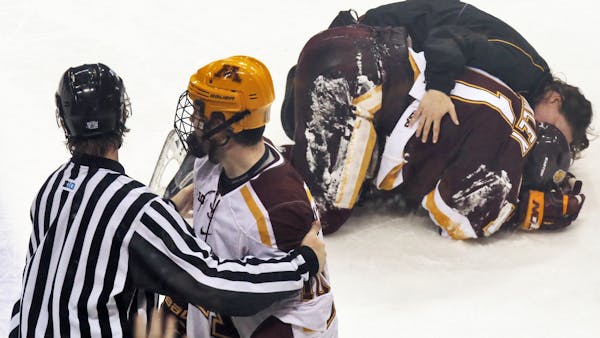Nobody saw it coming but Ben Marshall. The Gophers defenseman glided across his blue line and slammed into Minnesota Duluth's Austin Farley.
The hit sent Farley airborne before he slumped to the ice. Marshall retreated to the penalty box assuming a minor penalty would be called for a shoulder-to-shoulder hit.
Instead, Marshall received a major penalty — contact to the head, a game misconduct — and he was disqualified.
It was the latest example of a crackdown on certain hits, especially hits to the head.
"Safety violations have been and will continue to be a point of emphasis," said Steve Piotrowski, supervisor of Big Ten officials. "Head contact is becoming a focal point not just in college hockey but all levels. … NCAA hockey and pro hockey are not trying to take contact out of the game, but violent hits have to be brought to the surface. It's not about destroying someone with every hit."
Some believe college hockey could do even more to minimize potential major penalty hits by allowing instant TV reviews, something the NHL already has in place. The Big Ten has the technology with its command center in Chicago.
The emphasis on calling hits to the head, and the push for an instant review system, is a big part of college hockey's ongoing evolution.
Farley and Marshall get the point. Farley missed practice on Monday and will be a game-time decision for UMD on Friday at Western Michigan. Marshall was suspended one game for violating an NCAA rule that punishes players who collect three misconduct penalties in the same season.
Emphasis on safety
After officials made their call of a game misconduct, Marshall argued that there was nothing vicious about his hit. At midice, Gophers co-captain Nate Condon listened as the officials explained their decision. Taking into account the emphasis on safety, Condon said, their explanation made sense.
"That's been the change the last couple years, they've been a little more strict, especially with head contact," Condon said. "They thought [Marshall] got up high. Whatever the case was with the hit, any time you get up there, it's going to be an automatic call with the ref."
The same can be said about hits from behind.
Injuries have made players very aware of the danger surrounding hits near the boards. Marshall was also called for boarding on Saturday night, but slowed down and wrapped up his opponent before making contact.
Earlier this month, the Big Ten suspended Penn State's Mark Yanis one game for hitting a player from behind. Piotrowski and his staff reviewed video of the hit after the game and determined supplemental discipline was necessary.
Like Yanis' hit, Marshall's was also reviewed. Piotrowski wouldn't comment whether he agreed the hit justified a major penalty or not, but said an official's goal is always getting the call right.
"Some do warrant penalties and some don't. It's kind of a gray area. I think we all know what we don't want to see in the game, but I don't think you can penalize everyone for big hits," UMD coach Scott Sandelin said.
"That one on Marshall, I think that was a penalty. What's hard is everyone can go back and look at replays, but in the game you see what you see, and referees see what they see. Was it a good hit? Probably. The puck wasn't anywhere near, though, that was my issue."
Instant replays coming?
Sometimes even an officials huddle isn't enough to get the call right. Postgame video review can't reverse a call, either, and that's one reason the Big Ten and many coaches and players are in support of implementing in-game reviews on major penalties.
Farley believes the NCAA could protect its players better by adding a review system similar to the NHL's.
"Safety is a big issue with hockey 'cause it's such a fast game," Farley said. "That's where the reviewing process could handle that. That'd be taking the next step."
Gophers coach Don Lucia reached out to Piotrowski after Marshall's suspension. There was nothing the Big Ten could do other than listen to Lucia's support for being able to instantly review major penalties.
Lucia praised college football for setting precedence on in-game reviews of hits to the head. He wants the same thing for college hockey and the protection it would offer players making and taking hits.
The idea of reviewing penalties has been discussed at past coaches' association meetings and will likely be at the forefront in the current NCAA rule-change year. The rule would have to be approved by the NCAA for all Division I teams, and such a change might require an amendment exempting schools that do not yet have proper video feeds. Some believe that by this time next season, a hit similar to Marshall's could be immediately reviewed in Big Ten play.
Currently, in-game video is utilized only for reviewing goals.
"That's the rule today, and we'll live with the rule," Lucia said. "Ben understands it. I know he was frustrated and disappointed, but hopefully that is something we can get changed."
Marshall was not made available for interviews.
Michigan State coach Tom Anastos, whose team plays the Gophers this weekend, is the NCAA ice hockey rules committee chair. He spends a lot of time discussing rule enforcement and the introduction and modification of rules.
"Safety needs to be of the utmost importance. Referees are a big part of that," Anastos said. "An athlete is going to push the rules to the furthest extent you can. We all have a level of responsibility: coaches, players, officials. The officials have a hard one. They're held to accountability standards that really protect the integrity of the game."
Federal appeals court overturns West Virginia transgender sports ban

Official who helped MSHSL on pioneering ventures dies at 89

Twins demoting strikeout-prone Wallner to St. Paul

Talking Preps: New Maple Grove football coach fulfills a long-time dream

